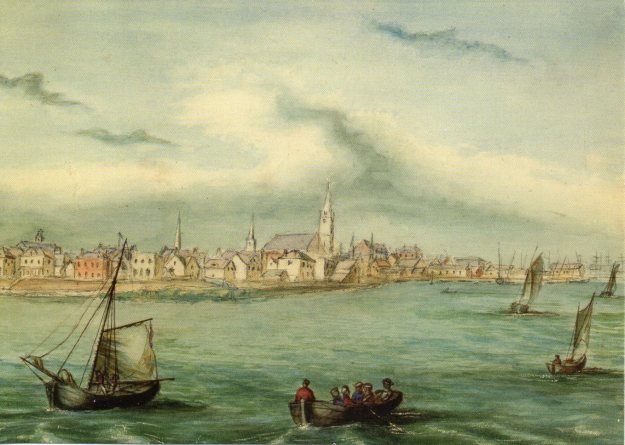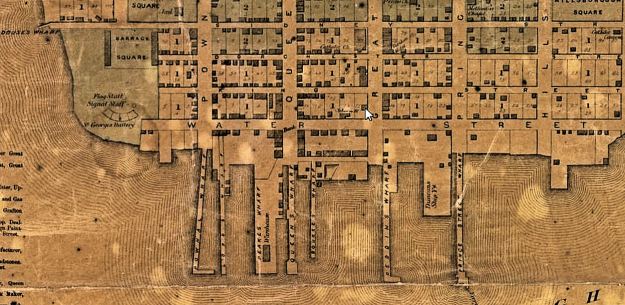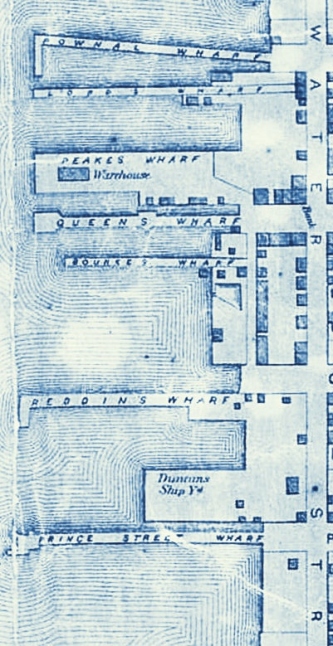Early in 1900 Elizabeth J. Macdonald, wife of Senator A.A. MacDonald, sat down to write her reminiscences of the Charlottetown she remembered from half a century earlier. Titled “Charlottetown Fifty Years Ago” and published in a series of 9 installments in the original Prince Edward Island Magazine in 1900 and 1901, her account provides a glimpse of the town at mid-century. This excerpt concerning the harbour was published in the June 1901 issue of the magazine.

Charlottetown waterfront from the south-west by Robert Harris (undated) collection of the Confederation Centre Art Gallery
And what are we to remember this time, what is there interesting to record? Is it the appearance Charlottetown presented to a stranger coming up the harbour, and what are we to imagine some of the many immigrants coming here from Scotland and Ireland in the early forties, and later on, thought of it? Some probably would see it very flat and unattractive, others look upon it as well-protected from the encroachment of any enemy, and others again would think it a comparatively busy place; that is if its numerous shipyards, with generally two or three vessels under construction, were any indication, and would decide there was plenty of work for all who were able or willing to do it.
The Douse shipyard being on the Douse property near the west end of Richmond Street was the first to meet the eye, as it showed up from the harbour, and there Mr. Douse built several vessels. The next to be seen was close by where the Stream Navigation Wharf now is, and where the second Gulnare was built in 1845 by Peake & Duncan. The first Gulnare was built in Quebec and came to Charlottetown in 1841, the same year that Captain Bayfield, Commander Bedford, Lieutenant Orlebar, and the other officers of the surveying staff came to take up their residence here. The second Gulnare not being quite up to their expectation, they had the third one built in Quebec. She proving a failure, the late Mr. Longworth undertook to build the forth. All were topsail schooners and we understand the fourth Gulnare was more satisfactory. After that they had their first steamer, the Margaretta Stephenson, built by and belonging to a firm in Quebec by the name of Stephenson.
Further along and almost directly below where the Duncan House now stands, was the Duncan shipyard where the ring of the workman’s hammer was constantly heard and there the largest ship ever built on this Island, registering 1791 tons, was launched in the year 1858, by the firm of Duncan. Mason & Co. and named the “Ethel” after Mr. Duncan’s only child. Mr. Heard’s shipyard was about where the railway yard now is, only nearer where the railway wharf is built. On the shore not far from the Kensington shooting range of today was McGill’s shipyard, where there appeared to be always a vessel on the stocks. Some of the old ship-builders used to say, was that ship building was like making patchwork quilts, that when one was finished there was almost enough material left to make another, and in that way they were induced to go on building. But the wooden ships of P.E. Island are almost among the things of the past and it is only now and again that we hear of a ship being built.
By 1863 when the map above was drawn the number of wharves had grown. Besides the municipal government wharves at Queen and Pownal streets additional wharves had been built: From west to east these were Lord’s Wharf (the stub of which forms the east wharf of the Charlottetown Yacht Club), the first of several Peake’s Wharves (later to be called the Plant Line wharf, then Poole & Lewis, and still later, Pickard’s), Bourke’s (also known as Tremaine’s and the ferry wharf before 1856) Reddin’s Wharf at the foot of Great George Street (which was later named the Steam Navigation Wharf) and then the Duncan shipyard. Furthest east was the Colonial government ferry wharf at Prince Street. Both Borque and Tremaine had been holders of the ferry contract in the 1840s and 1850s.
In an earlier article in the series which was published in June 1900, Ellen MacDonald had recalled the wharves and ferry service of her youth:
As far as we can remember there were only three wharves, Queen’s Wharf at the end of Queen Street, Peake’s Wharf on the west side of Queens, and Tremaines, or the Ferry Wharf on the east side of Queen’s. All the wharves were much shorter than now; Tremaine’s was only a few blocks or piles long, quite long enough for the sail and team boats that crossed to Southport. A sailboat crossed on Mondays and a team-boat on other days of the week. The team-boat was run by two or sometimes three horses. There was a large wheel in the middle of the boat, (just such a one as is used in a tannery to grind bark) to which the horses were attached; the horses going round and round in a circle, turned the wheel and propelled the boat. Passengers came from the Southport side and returned again about four times a day, twice in the morning and twice in the afternoon.
A story is told of a middle-aged lady who came across the ferry to do some shopping She had not taken into consideration that the tide was falling when she left home; it was one of the sail-boat days and when she got to the Charlottetown side the tide was low, and she being very stout and heavy, could not climb the wharf, neither could her friends lift her up so she had to remain in the boat for some hours, until the tide fell lower and then rose sufficiently high for her to reach a proper stepping place. That was one of the inconveniences of long ago.



Would love to see a close up of the Rocky Point ferry docked at the bottom of Prince Street.
Thanks for this! Do you know if/where those 1900-1901 issues of PEI Magazine can be found online?
The full run of the Prince Edward Island is available on-line at
https://www.canadiana.ca/search/?q0.0=%22Prince+Edward+Island+Magazine%22